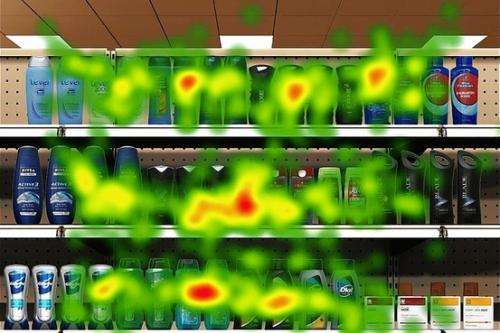July 16, 2012 weblog
Consumer product giants' eye-trackers size up shoppers

(Phys.org) -- Consumer product giants whose supply chains, profit margins, and boardroom reports depend on how fast the paper towels, shampoo, and diapers can fly off the shelves no longer dare to rely on just focus groups or survey handouts for consumer data. Technology is supporting retailers and marketers with sophisticated ways. “Neuromarketing” has become a frequently used term to describe a shopping environment where advanced technologies s including eye tracking reveal consumer wants and shopping behavior.
Dr. Stephen Sands of Sands Research, for example, has done research on consumer behavior in supermarkets using a mobile EEG technique and eye tracking in a real supermarket environment. Researchers like Sands are getting a better read on what the newer technologies can actually say about consumer behavior.
Businesses use the data that eye tracking collects to make decisions on product weight, package design, and where to put the items on shelves. They cannot rely just on what shoppers report back because research indicates that shoppers may say they like a product yet their purchases tell a different story. Marketers in turn look to eye-tracking solutions as helpful tools for better understanding shopping behavior.
New 3-D computer simulations of shopping experiences augmented with eye-tracking technology and brain-wave monitoring are taking the place of conventional market research, according to a report this week in The Wall Street Journal.
Eye-tracking collects eye data points when people are looking around a store. Eye tracking is also used to tell how the floor plan and design of the store are affecting the consumer.
According to the WSJ, three company giants, Unilever, Procter & Gamble, and Kimberly-Clark, are combining three-dimensional computer simulations of product designs and store layouts with eye-tracking technology.
Kimberly-Clark's researchers in the past have used computer screens outfitted with retina-tracking cameras when testing packaging for paper towels. Their goal was to find which designs got noticed in the first ten seconds a shopper looked at a shelf. They also wanted to know if the preferences held up on different count packages, from single rolls to multipacks.
Types of eye-tracking equipment may range from a special camera that is embedded in the rim of a computer screen to free-standing devices. Prices may run as high as $25,000 to $40,000, depending on the type of system.
Data visualization results may be in the form of heat maps, the most familiar kind, where collected information forms a heat map that uses color to show where people looked.
Another data visualization format is the Gaze Plot which shows a diagram overlaying an image of the ad or product package. Gaze Plots display the order that someone looked at a point, how long they looked at the point in relation to other points, and the path that person’s eyes took. The Gaze Plot is considered useful to learn what drew the attention of the customer, if the message was easy to interpret, and if the customer became confused at any point.
© 2012 Phys.org




















